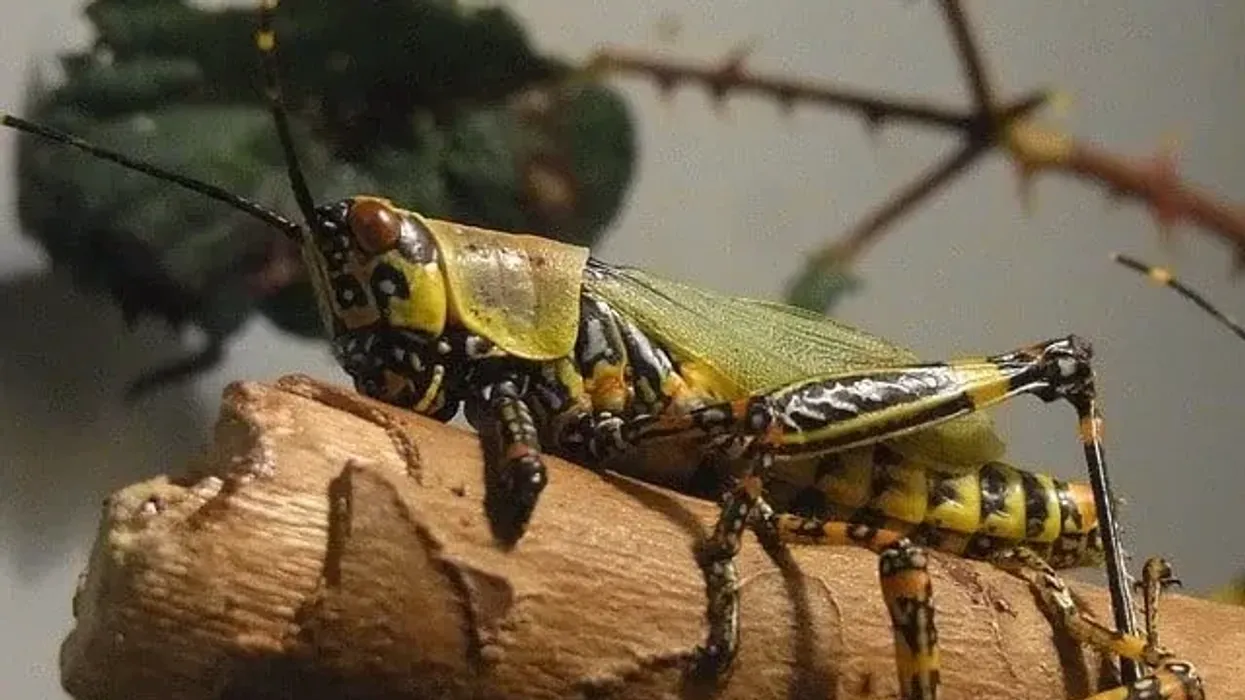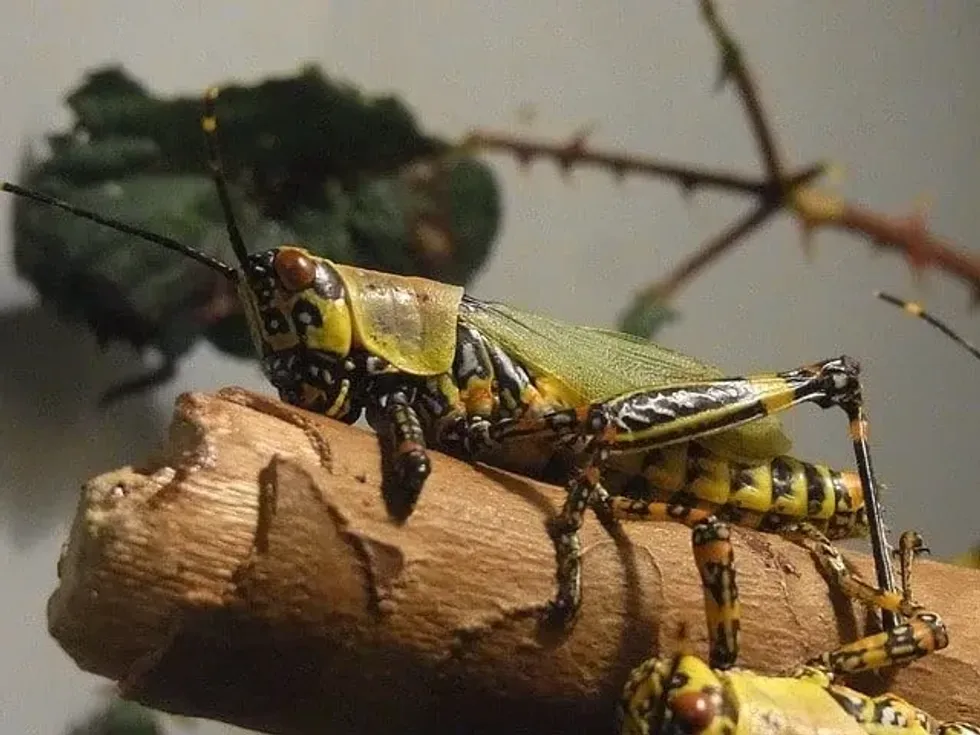A sudden rainfall not only brings cool breezes, it sometimes welcomes surprises and unexpected guests. Locusts resemble migratory grasshoppers and attack in swarms, devastating agricultural land, and damaging crops. So why does this locust migrate?
The migrating nature of these insects is a spontaneous activity because of sudden rainfall. Locusts attract each other and join to become a plague of insects ranging from thousands to billions of locusts. Locusts are active, colorful, and quickly attracted to other locusts.
Let us explore some interesting facts about one of the locust species, migratory locusts. To learn more about other species, check out stink bug facts and ghost ant facts.
Migratory Locust Interesting Facts
What type of animal is a migratory locust?
The migratory locust is an insect belonging to the genus Locusta and is native to Australia. Locusts are usually seen in grasslands and are highly migratory.
What class of animal does a migratory locust belong to?
The migratory locust belongs to the Insecta class. The species that belong to this class have three main body parts -head, thorax, and abdomen.
How many migratory locusts are there in the world?
There is an uncountable number of migratory locusts in the world. As per records, there are ten species of locusts.
Where does a migratory locust live?
The migratory locust (Locusta migratoria) is native to Australia. Its distribution is observed in the grasslands of Africa, tropical Australia, New Zealand, parts of Eurasia south of the taiga, and the East Indies.
Locusta migratoria migratorioides are a subspecies of this locust, widespread in Australia, East Timor, Papua New Guinea, and Indonesia. In Australia, they are found in Queensland's Central Highlands in more significant numbers.
What is a migratory locust's habitat?
The highly mobile migratory locust habitat is tropical and subtropical regions and is grasslands, agricultural fields, and lands with crops such as sugarcane or wheat.
Who does migratory locust live with?
The migratory locust is a polyphenic insect. Polyphenism is something where two or more different phenotypes are seen in one organism in terms of its behavior, appearance, and development. The main phases of this migratory locust are the solitary phase and gregarious phase.
How long does a migratory locust live?
The exact life span of the migratory locust is unknown. But in general, the lifespan of any locust ranges from three to six months, whereas the lifespan of a desert locust is around three to five months.
How do they reproduce?
The migratory locust life cycle undergoes three stages, egg, nymph, and adult stage. The favorable egg-laying sites for migratory locusts are moist soil beds in agricultural lands, silt beds formed by soil erosion, and creek beds.
Female locusts lay between three and five egg pods in her lifetime; each egg pod consists of 50-100 eggs. The eggs cannot survive in hot temperatures or dry seasons. It takes 11-15 days for eggs to develop in the nymph.
The nymph undergoes five molts and passes 30 days before changing into an adult locust. These nymphs become highly gregarious when present in large numbers and form compact bands.
The adult migratory locust lives for at least two months and sexually mature within 14 days. In a year, the female can give birth to five or six generations. Because of this, we can see all stages of locusts in the same area.
What is their conservation status?
As per IUCN, the conservation status of migratory locusts is of Least Concern.
Migratory Locust Fun Facts
What do migratory locusts look like?

The migratory locusts are the most widespread locust species that pass from solitary to gregarious, with some intermediate phases in between. Based on the phases and age, the characteristics, pigmentation, and size of this locust change.
Solitary larvae are green or brown with varying extents, while migratory gregarious larvae have a yellow to orange covering with black spots. The gregarious adult is brownish with yellow, and this color becomes more intense upon maturation.
The solitary adult is brown with a varying extent of green color, which depends on the color of vegetation. The size of gregarious adults is smaller than the size of solitary adults.
The main migratory locust characteristics include three sections, the head, thorax, and abdomen. Appearance-wise this insect is a heavily built insect with a blocky appearance with greenish-yellow hind wings, fine hair on the chest, antennae less than half of the body, chewing mouthparts.
They have solid rear legs for jumping, and adult flight is solid and steady. The front part of the thorax has a strong shield.
How cute are they?
Though locusts are not dangerous species, one may not see them as cute because the damage they do to the environment by attacking in swarms and destroying the crops is a threat to the country's economy.
How do they communicate?
It is amusing that how millions of locusts can travel in the same direction. What makes them attract each other? In gregarious phase, while swarming all the group of locust moves in the same direction as their neighbors but suddenly they change their direction as a group.
Researchers found that migratory locust emits vinylanisole as the essential pheromone from a brew of 35 volatile chemicals. This chemical compound helps in attracting locusts to each other. They make clicking sounds and stop when approached.
How big is a migratory locust?
On average, the measurements of the migratory locust are 2.36 in (60 mm) long 0.59 in (15 mm) in width. They are a little larger than the mole cricket, which is 2 in (50 mm).
How fast can migratory locusts move?
The migratory locust travels with a speed of 9.3 - 12.4 mph (15 -20 kph). In comparison, swarms can travel 3.10 - 80.7 mi (5 -130 km) or more in a day. Thus, there may be 40-80 million individuals in a locust swarm.
How much does a migratory locust weigh?
The average weight of the migratory locust is unknown; a single locust is expected to weigh up to 0.07 oz (2 g).
What are the male and female names of the species?
The male and female species are called male migratory locusts and female migratory locusts. The adult male locusts are smaller in size when compared to the female adult locust. In addition, in the male species, the end of the abdomen is rounded; in females, it is pointed.
What would you call a baby migratory locust?
The baby's migratory locust is called nymphs. Nymphs are similar to adults, but they lack wings to fly. When they start growing, these nymphs shed their skin and change into adults in 30 days.
What do they eat?
The primary food of a migratory locust (Locusta migratoria) is grass. So, they attack grasslands and pastures in no time, where an adult locust eats several pounds of fresh food. Thus, a swarm of locusts may eat almost 1 t (907 kg) of food.
Are they harmful?
Though locusts are not harmful and do not kill humans, they are experts in damaging the vegetation and crops in a large area. The locust swarms voraciously attack one of the crops, trees, and other plants.
Though their bite is not poisonous, they contain chemical residues, which are highly toxic to humans. A 0.6 mi (1 km) swarm of locusts containing 40 million individuals can destroy a crop that 35000 people may rely on in one day.
Though it is impossible to completely eradicate the problems created by locusts, one of the most adopted techniques to control these insects is using organophosphate chemicals in small doses by aerial spray methods and handheld sprayers and knapsack methods lesser extent attacks.
Would they make a good pet?
Some people are interested in keeping these species as pets. Desert and migratory locusts are the best options as a pet. Desert locusts depend on broad leaves, whereas migratory locusts should be provided grass as their food.
Proper lighting, background heat, and a plastic cage with dimensions 11 in x 6.2 in x 4 in (28 cm x 16 cm x 10 cm) is enough for a couple of adult pairs, with suitable temperature should be taken care of.
Did you know...
The migratory locust is widespread in all the continents except Antarctica and North America. The predators of the locusts are spiders, wasps, snakes, raccoons, opossums, and birds.
Do you know? If you inject serotonin into a timid grasshopper, within two to three hours, the grasshopper changes into a gregarious locust.
Desert locusts are the most harmful migratory locusts.
Naming the migratory locust
Locust is a short-horned grasshopper and is a gregarious insect. Many other grasshoppers with gregarious and migratory characteristics are grouped under locusts in general; therefore, it is not known why a locust is named migratory locust. These species are present in various habitats, adapting well to various environmental conditions.
Are migratory locusts edible?
Migratory locusts are consumed by humans. These insects are rich in proteins, dry matter, vitamins, and minerals. Scientists have done many types of research on these edible insects and identified that they are composed of 490.8 Kcal/100g calories. In Switzerland, this migratory locust is officially approved to use in food.
Here at Kidadl, we have carefully created lots of interesting family-friendly animal facts for everyone to discover! Learn more about some other arthropods from our fairyfly fun facts and stick bug fun facts for kids pages.
You can even occupy yourself at home by coloring in one of our free printable migratory locust coloring pages.









